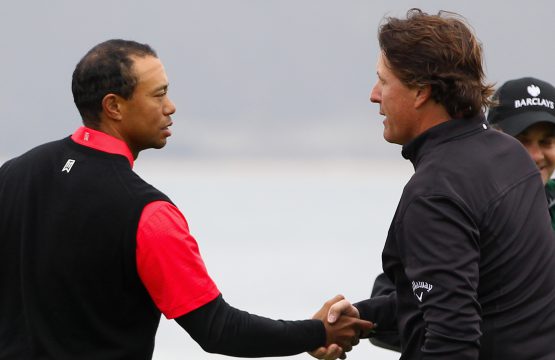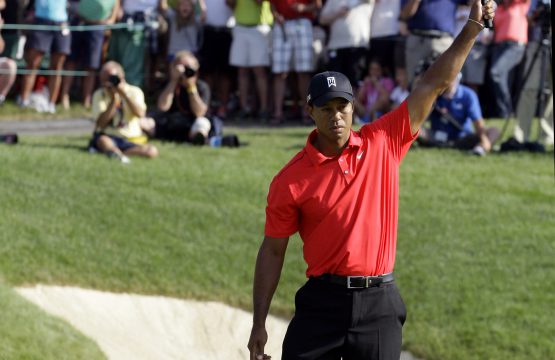Redone Olympic to require precise shot-making
Tiger Woods played an early practice round by himself Monday at the Olympic Club in San Francisco, site of this week’s 112th U.S. Open Championship. The weather was cool and sunny, as most of the 156 players begin preparation for the tournament proper, Thursday through Sunday, on the famed Lake Course.
Asked if the course, located adjacent to the Pacific Ocean and susceptible to fog, is firming up, Woods replied, “It’s getting there.”
Tiger is no stranger to the course, having played it several times during his college days at Stanford University, about 45 minutes south of Olympic. Two weeks ago, he and caddie Joe LaCava flew in for a quick practice round and liked what they saw.
“I think is sets up well for my game,” Woods said.
Woods seldom hit driver on the 7,170-yard, par-70 layout, which is hosting the U.S. Open for the fifth time. Although the course has been lengthened 357 yards since it last held the Open in 1998, and about half the holes have new tees, the character is still the same. Seven holes feature doglegs — four right-to-left and three left-to-right — and with the fairways expected to be hard, poorly-placed tee shots will release into the rough and trees that border every hole.
In other words, Olympic requires precise shot-making to small, sloping, traditional greens that will be firm and unforgiving. All have been redone since ’98, and they now feature bentgrass, which should be true and smooth.
The seventh, 15th and 18 greens have been carefully modified to their original shapes, which should create more pin placements. In addition, the new 200-yard, par-3 eighth hole will play 60 yards longer than its predecessor, and the green is flanked by large Monterey Cypress trees on the left. A large hill sits to the right of the hole, just below the clubhouse, and will provide a prime viewing area for fans.
With only two par-5s on the course — Nos. 16 and 17 — birdies will be hard to come by early in the round, especially on the first six holes. The 520-yard, par-4 first hole normally plays as a par-5 for members and will immediately put players to the test. The green slopes from front to back, so holding long irons or rescue clubs will not be easy.
The par-4 second hole measures 428 yards, and the fairway has been moved to the left, making it tougher to hit. The slender green is also difficult to hit and slopes severely from back-right to left-front. The 247-yard, par-3 third hole plays downhill to a green that slopes from front to back and is protected by bunkers on both sides. Wind can be tricky, so don’t be surprised if this hole ranks among the toughest in the tournament.
The 430-yard, par-4 fourth hole starts downhill, then doglegs left and features a blind, uphill second shot. As with the second hole, most players will hit 3-woods or long irons off the tee to avoid deep rough along the right side of the fairway. The 498-yard fifth hole is the reverse of No. 5 and doglegs from left-to-right. Trees border both sides of the fairway and the downhill second shot plays slightly short of the yardage. Players will be wise to stay below the hole, as the green slopes from back to front and is extremely slippery. In the 1998 Open, the fourth and fifth holes ranked among the most difficult in the tournament.
About 45 yards have been added to the sixth tee, and the hole now plays 490 yards. It boasts the only fairway bunker along the left side of a hole on the course, and it has been moved slightly to the right to catch errant tee shots. A good drive could lead to a birdie, as the second shot plays downhill. However, there is a false front to contend with and the putting surface slopes from back to front.
The popular consensus is that any player who can tour the first six holes in 1- or 2-over par will have a big edge on the field. The short par-4 seventh hole, drivable for long hitters, is the best birdie opportunity on the front nine.
The 424-yard, par-4 10th slides from left to right but will leave a short iron to the green and a good birdie chance. The par-4 11th measures 449 yards but plays uphill all way. Nothing tricky, but the long, skinny green slopes from back to front.
The 451-yard, par-4 12th has added 30 yards and is no longer a pushover. The fairway is narrow and tightly guarded by trees on both sides, which is intimidating from the tee. The green is small and protected by bunkers on both sides. This is where Payne Stewart’s drive came to rest in a divot in ’98, resulting in a key bogey down the stretch on Sunday.
At 190 yards, the par-3 13th seems harmless, but is well bunkered left and right. In addition, a large ivy-covered Monterey Cypress tree just short of the green on the right is like a ball magnet. The bank just left of the green has been shaved and is not a good place.
The fairway at the 419-yard, dogleg-left, par-4 14th has been moved to the left, which brings trees into play. However, if a player can hook a driver or 3-wood along the right side, the ball will release to the bottom of the hill, leaving a short, uphill wedge or sand wedge.
The 154-yard, par-3 15th hole is the shortest par-3 at Olympic and should produce some birdies. Although one can’t see the green from the tee, a deep bunker sits just in front of the green and balls have been known to plug in the face. According to the local caddies, this is the only green on the course that breaks toward the clubhouse, away from Lake Merced.
At 670 yards, the par-5 16th is the longest par-5 in U.S. Open history. Even at its former length of 609 yards, only a handful of players have ever reached this double-dogleg left in two. The new back tee will likely be used twice during the tournament. Two prodigious woods will result in a short iron to the green and a good birdie possibility.
The slightly uphill, 505-yard, par-5 17th has previously been played as a long par-4. This is truly a risk-and-reward hole for long hitters, who can reach the green in two, but trouble lurks. The key is finding the fairway, which slopes sharply from left to right. A new pot bunker has been added short-right of the green, and the grass has been closely mown right and long, which can cause all kinds of problems for errant second and approach shots. The green slopes from back to front and is arguably the toughest on the course.
The 335-yard, par-4 finishing hole appears harmless, but always seems to hold its own. The slivery green slopes severely from back to front and is surrounded by a natural amphitheater. Most players will hit mid to long irons off the tee and will be left with short approach shots. Looks simple enough, but the green is well bunkered and doesn’t surrender birdies easily. Although purely coincidental, if one looks from the tee to the green, from left to right, the bunkers spell, “I-O-U.”
Woods is expected to play an early-morning practice round Tuesdday with former Stanford teammate Casey Martin, who is now the golf coach at the University of Oregon.


